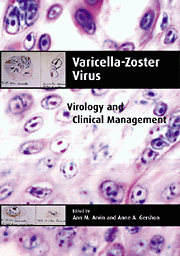17 - Laboratory diagnosis of infection
from Part IV - Laboratory Diagnosis
Published online by Cambridge University Press: 02 March 2010
Summary
The laboratory diagnosis of varicella-zoster virus (VZV) infections has been improved by the development of techniques and production of new reagents including use of specific monoclonal antibodies (mAbs) to detect VZV viral antigens directly from vesicle smears by immunofluorescence antibody (IFA) staining, eliminating cross-reactivity with other herpesviruses; production of VZV DNA probes for dot-blot hybridization; and in situ hybridization and polymerase chain reaction (PCR) methods to detect VZV nucleic acid in clinical samples. Serological tests have been developed to measure VZV IgA, IgM, and IgG antibodies, such as enzyme immunoassays (EIAs), which are useful for rapid serodiagnosis and suitable for small or large scale epidemiological studies. These new techniques provide the clinician and diagnostician with an increasing array of tests for rapid, accurate and early diagnosis of VZV infections. These approaches can help both in the management of the individual patient and in instituting appropriate public health measures in response to epidemics (Gershon & Forghani, 1995).
Collection and preparation of clinical specimens
A key requisite for the successful laboratory diagnosis of VZV infection is to obtain a proper clinical sample, collected at the right time in the clinical course, from the right site, and transported to the laboratory in good condition. Since clinical samples are usually in very limited quantity and a large number of assays is available, careful selection of the appropriate test is necessary to ensure a proper viral diagnosis. Collection of clinical samples should be goal-oriented, depending on whether the sample is intended to be tested for direct detection of viral antigens by IFA staining, nucleic acid amplification by PCR, or virus isolation, since each method has different conditions and criteria for specimen collection.
- Type
- Chapter
- Information
- Varicella-Zoster VirusVirology and Clinical Management, pp. 351 - 382Publisher: Cambridge University PressPrint publication year: 2000
- 9
- Cited by

